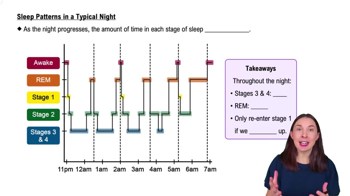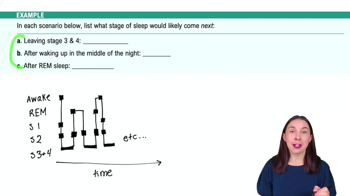Table of contents
- 1. Introduction to Psychology1h 43m
- 2. Psychology Research2h 20m
- 3. Biological Psychology2h 41m
- 4. Sensation and Perception28m
- 5. Consciousness and Sleep32m
- 6. Learning41m
- 7. Memory34m
- 8. Cognition37m
- 9. Emotion and Motivation35m
- 10. Developmental Psychology33m
- 11. Personality48m
- 12. Social Psychology41m
- 13. Stress and Health41m
- 14. Psychological Disorders44m
- 15. Treatment47m
5. Consciousness and Sleep
Sleep
Struggling with Psychology?
Join thousands of students who trust us to help them ace their exams!Watch the first videoMultiple Choice
Last night, Kayla thought she was awakened by a noise she heard outside of her bedroom door. When she tried to get up to see what was going on, she found she could not move. She tried to scream but could not make a sound. After several minutes, she was finally able to sit up and wondered what had just happened. The best explanation for Kayla's experience, according to sleep researchers, is that she experienced
A
a drug-induced hallucination.
B
side effects from increased amounts of REM sleep.
C
a nightmare during deep sleep.
D
sleep paralysis during REM sleep.
 Verified step by step guidance
Verified step by step guidance1
Understand the context: Kayla experienced an inability to move and speak upon waking, which is a key symptom to consider.
Identify the phenomenon: The symptoms described are characteristic of sleep paralysis, a condition where a person is temporarily unable to move or speak while falling asleep or upon waking.
Connect to sleep stages: Sleep paralysis is often associated with REM (Rapid Eye Movement) sleep, a stage where vivid dreaming occurs and the body experiences temporary muscle atonia (paralysis) to prevent acting out dreams.
Differentiate from other options: Drug-induced hallucinations, side effects from increased REM sleep, and nightmares during deep sleep do not typically involve the inability to move or speak upon waking.
Conclude with the best explanation: Based on the symptoms and understanding of sleep stages, the most accurate explanation for Kayla's experience is sleep paralysis during REM sleep.

 3:25m
3:25mWatch next
Master Circadian Rhythms with a bite sized video explanation from Hannah Gordils
Start learningRelated Videos
Related Practice


































































































![Race, Genes and IQ Differences | Bret Weinstein [Mini Clip]](https://img.youtube.com/vi/IztL_m3pd70/mqdefault.jpg)



































































































